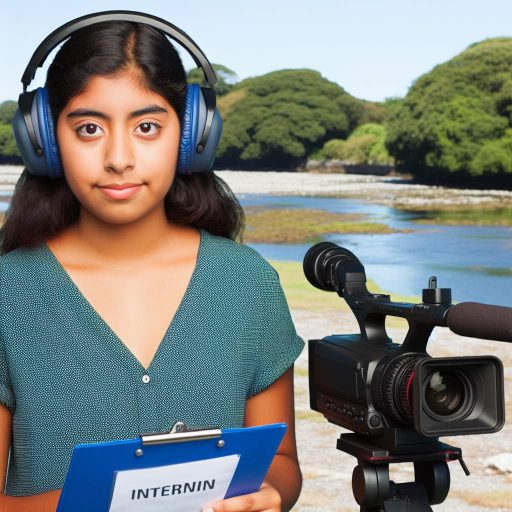Introduction
Writing for television and writing for film represent two distinct art forms.
Each format requires unique skills and approaches.
Television writers often develop episodic arcs, while film writers focus on a singular narrative.
In this blog post, we will explore the key differences between these mediums.
Structure
Film typically follows a three-act structure, condensing the story into two hours.
This format demands tight pacing to maintain viewer engagement.
In contrast, television often employs a serialized format, allowing for longer character development over multiple episodes.
Each episode can act as both a standalone story and part of a larger narrative.
Character Development
Character arcs differ significantly between the two mediums.
In film, character growth usually occurs within a limited timeframe.
Writers must deliver a complete transformation by the end.
Television, however, allows more time for nuanced development.
A character can evolve gradually across several seasons.
The Audience
Television writers often consider weekly viewer engagement.
They create cliffhangers to encourage audiences to return.
With film, the audience experiences the story in one sitting, generating a different type of emotional investment.
This immediacy necessitates a more gripping narrative drive.
Collaboration
The collaborative nature of writing also varies between the two fields.
Film writers frequently work in isolation, crafting scripts before sharing with directors.
Meanwhile, television writers often collaborate within a writers’ room.
Transform Your Career Today
Unlock a personalized career strategy that drives real results. Get tailored advice and a roadmap designed just for you.
Start NowThis collective environment fosters diverse ideas and quick adjustments.
Unique Challenges and Rewards
Writing for television and writing for film each offer unique challenges and rewards.
Understanding these differences can help aspiring writers navigate their careers.
Whether crafting a feature film or an engaging television series, both mediums require creativity and skill.
Differences in Format
Writing for television and film requires distinct approaches.
Each medium comes with its own structural rules.
Understanding these differences is vital for effective storytelling.
Television Script Structure
Television scripts typically follow a structured format, especially within episodic series.
This approach allows writers to build a narrative arc over multiple episodes, keeping audiences engaged week after week.
Here are some key features of television script structure:
- Episodes as Standalone Narratives: Each episode usually tells a complete story. However, these stories often evolve within an overarching plot.
- Act Structure: Most TV shows employ a three or four-act structure. This format creates dramatic tension and ensures proper pacing.
- Cold Opens: Many television scripts start with a cold open, introducing a hook before the opening credits. This keeps viewers intrigued from the start.
- Segmented Scenes: Scenes are short and often divided by commercial breaks in traditional broadcasting. This segmentation influences pacing and scene dynamics.
In contrast, film scripts aim for a singular narrative experience.
The entire story unfolds within a typically two-hour timeframe.
Film Script Structure
- Feature-Length Format: Film scripts are designed for about 90 to 120 pages. Each page generally equals one minute of screen time.
- Three-Act Structure: Films often follow a clear three-act structure: setup, confrontation, and resolution. This model supports a compact narrative.
- Character Arcs: Character development is more concentrated. Films execute character transformations in a shorter time frame than television.
- Less Segmentation: Film scripts avoid segmented scenes. A continuous viewing experience leads to deeper immersion.
Differences in Length and Pacing
Length and pacing play crucial roles in differentiating television from film.
Understanding these aspects can significantly impact a writer’s effectiveness.
Television Length
Television episodes generally last between 20 to 60 minutes.
This shorter duration creates a distinct rhythm in storytelling:
- Condensed Storytelling: Writers must condense plots into limited timeframes. This focus demands efficient dialogue and concise character development.
- Seasonal Arcs: TV shows often embark on seasonal story arcs, allowing more extensive plots to develop over time.
- Recaps and Catch-ups: Many series include recap segments to remind viewers of crucial plot points, enhancing storytelling continuity.
On the other hand, film lengths differ significantly.
Film Length
- Extended Time: Feature films provide more time—typically 90 to 180 minutes. This allows for more complex narratives and character arcs.
- More Detailed Scenes: Film pacing allows for longer scenes, enabling deeper emotional engagement.
- Dynamic Shifts: Films can utilize long takes and detailed cinematography, offering varied pacing and visual storytelling.
Importance of Understanding Format Differences
Recognizing the nuances between television and film formats is crucial for writers.
Grasping these differences guides writers in creating compelling narratives.
Here’s why understanding format matters:
Transform Your Career Today
Unlock a personalized career strategy that drives real results. Get tailored advice and a roadmap designed just for you.
Start Now- Tailored Storytelling: Writing for television requires different techniques than writing for film. Adapting your style for each medium enhances storytelling effectiveness.
- Audience Engagement: Knowing how audiences consume content in each medium shapes your story choices. TV often promotes ongoing engagement, while film aims for a single experience.
- Cultural Context: Different formats reflect societal norms and viewer expectations. Writers must consider how these aspects influence storytelling.
- Career Opportunities: Writers skilled in both mediums increase their professional versatility. They can navigate various industries, expanding their creative reach.
Ultimately, the nuanced differences between writing for television and film dictate the approach a writer should take.
Each format demands a tailored strategy, engaging audiences uniquely.
Writers equipped with this knowledge can craft meaningful stories that resonate across platforms.
How Audiences Consume Television Shows vs. Films
Audiences approach television and film differently.
This distinction profoundly influences writers.
Here’s how:
- Viewing Habits: Audiences may binge-watch multiple episodes of a series, allowing for deeper engagement with characters.
- Attention Span: Television programming caters to shorter attention spans.
- Accessibility: People often watch television in more casual settings.
- Time Commitment: Films demand a larger time investment.
The Impact of Viewer Expectations on the Writing Process
Viewer expectations differ markedly between television and film.
Understanding these expectations shapes how writers approach their craft.
Here are some key expectations:
- Character Development: In television, viewers expect ongoing character arcs.
- Plot Progression: Films provide a complete plot in a single package.
- Tone and Genre Consistency: Audiences expect consistency in tone.
- Series Length and Renewal: Anticipating renewals, television writers plan arcs across seasons.
The Need for Writers to Consider Audience Engagement Throughout the Storytelling Process
Writers must prioritize audience engagement throughout the storytelling process.
Here’s how they can achieve this:
- Creating Cliffhangers: Television writers often use cliffhangers at the end of episodes.
- Interactivity and Feedback: Writers can gauge audience reactions through social media.
- Character Relatability: Writers should focus on making characters relatable.
- Story Arc Planning: Writers need to plan story arcs well in advance for television.
Balancing Expectations and Engagement
Writers face the challenge of balancing viewer expectations and engagement.
Achieving harmony between these aspects can elevate the storytelling experience.
Here are strategies writers employ:
- Utilizing Familiar Tropes: Writers can leverage audience familiarity with certain tropes.
- Cultivating Community: Television writers encourage fan interactions.
- Incremental Reveals: Writers may choose to gradually reveal plot details.
- Emotionally Charged Scenes: Including high-stakes, emotional moments engages viewers.
Understanding Audience Engagement for Effective Storytelling
Understanding the nuances of audience engagement is crucial for writers working in television and film.
Through tailored storytelling, they can captivate viewers and cultivate loyal followings.
By embracing the unique challenges and expectations of each medium, writers can enhance their craft and create unforgettable experiences for their audiences.
The differences in how audiences consume television shows and films shape the writing process fundamentally.
Whether engaging viewers through episodic cliffhangers or by crafting a complete cinematic experience, writers must be keenly aware of their audiences.
Successful storytelling lies in the delicate balance between meeting viewer expectations and keeping them engaged, ensuring they return for more.
Transform Your Career Today
Unlock a personalized career strategy that drives real results. Get tailored advice and a roadmap designed just for you.
Start NowLearn More: How to Improve Your Copy Editing Speed
Character Development in Television vs. Film
Character development serves as a cornerstone of storytelling, whether in television or film.
Both mediums strive to create compelling characters, but their approaches significantly differ.
Let’s explore these key distinctions.
Differences in Character Development
- Time Constraints: Film has a relatively brief runtime, usually around 90 to 180 minutes.
- In contrast, television series typically run for multiple seasons, allowing for gradual character growth.
- Depth vs. Brevity: Due to shorter narratives, films often rely on archetypes and immediate traits.
- Television can dive deeper into a character’s backstory, relationships, and motivations over time.
- Static vs. Dynamic Progression: In film, characters often undergo quick transformations within a single story.
- In television, characters experience long-term changes, shaped by ongoing events and viewer feedback.
Challenges of Developing Characters Over Multiple Seasons
Writing for television poses unique challenges for character development:
- Maintaining Consistency: Writers must ensure that characters remain true to their established traits.
- Inconsistencies can frustrate loyal viewers and undermine story credibility.
- Evolving Roles: As a series progresses, characters may evolve in unexpected ways.
- Writers need to balance viewers’ expectations with innovative storytelling.
- Audience Expectations: Fan theories and feedback can influence character development.
- Writers often feel pressure to adjust arcs to align with audience sentiments, which can dilute original plans.
- New Characters: Introducing new characters can enrich storylines.
- However, balancing established and new characters presents a challenge.
- Writers must integrate new narratives without overshadowing established ones.
Character Arcs: Depth and Complexity
The depth and complexity of character arcs differ between television series and films:
- Layered Arcs: Television offers the opportunity for layered character arcs.
- Writers can explore conflicts, growth, and achievements over seasons.
- In film, arcs often conclude within the story’s framework.
- Multi-faceted Relationships: TV series allow for the exploration of intricate relationships.
- These dynamics shift throughout the series.
- In films, relationships are often simplified to fit the narrative structure.
- Backstory Exploration: Television often delves into characters’ pasts through flashbacks and subplots.
- Films typically summarize these backstories, focusing on the present conflict.
- Redemption Arcs: Television can provide ample room for redemption arcs.
- Characters may make mistakes and learn from them over seasons.
- In films, these arcs usually resolve quickly.
Writers often face a delicate balance between storytelling and character consistency in both mediums.
While films tend to focus on compact narratives, television explores character nuances through long-term engagements.
As the landscape of storytelling continues to evolve with platforms like streaming services, understanding these differences will aid writers in their creative journeys.
Find Out More: How to Network in the Audio Engineering Industry
When comparing writing for television and writing for film, the differences in story structure become apparent.
These differences shape how stories are told and perceived by audiences.
Writers need to understand these distinctions to effectively convey their narrative.
Three-Act Structure in Film
Most films adhere to a classic three-act structure.
This structure serves as a backbone for feature-length storytelling.
Below are the main components of this structure:
- Act One – Setup: Introduces characters, setting, and the central conflict. It hooks the audience and sets the stakes.
- Act Two – Confrontation: Characters face obstacles and develop, leading to a climax. This act builds tension and deepens the audience’s emotional investment.
- Act Three – Resolution: Provides closure. The conflict resolves, and character arcs conclude, delivering a satisfying payoff.
This three-act format pushes writers to create a concise, focused narrative.
The limited runtime demands tight storytelling, which can lead to profound emotional moments.
Films often explore themes deeply but within a shorter time frame.
Consequently, writers must master the art of brevity without sacrificing character development.
Episodic Structure in Television
In contrast, television often favors an episodic structure.
Transform Your Career Today
Unlock a personalized career strategy that drives real results. Get tailored advice and a roadmap designed just for you.
Start NowEach episode typically runs for 22 to 60 minutes.
This format allows for variation in storytelling.
Below are key characteristics of episodic structure:
- Single-episode arcs: Many episodic shows focus on self-contained stories. Each episode resolves its conflict while often contributing to larger storylines.
- Season-long arcs: Some series develop overarching plots across entire seasons. These larger arcs create suspense and encourage binge-watching.
- Character-driven storytelling: With longer formats, character development unfolds gradually. Viewers build deeper connections with characters over multiple episodes.
This flexibility allows television writers to experiment with different narrative styles.
They can use episodic storytelling to explore themes more organically.
Writers have the ability to engage viewers over extended periods, providing richer character landscapes.
However, this freedom comes with its own challenges.
Maintaining momentum and interest across episodes requires careful planning.
Cohesive Story Structure in Both Mediums
Despite the structural differences, maintaining a cohesive story structure remains crucial in both mediums.
Writers for both film and television face similar hurdles:
- Character Consistency: Writers must ensure that characters remain believable and consistent. Inconsistent character motivations can alienate audiences.
- Thematic Development: Central themes should resonate throughout the narrative. Both mediums need a clear message or exploration of ideas.
- Conflict and Resolution: Every story demands conflict. Successfully resolving conflicts creates a sense of satisfaction for the audience.
- Audience Engagement: Writers in both mediums should aim to captivate their audiences. This engagement keeps viewers coming back for more.
A strong story structure establishes a solid foundation.
Writers create the building blocks for compelling narratives.
By identifying each act in film or episode in television, they can construct satisfying arcs and climaxes.
This structured approach also fosters effective pacing, guiding audiences through emotional highs and lows.
Differences in Audience Expectation
Audiences have varied expectations for films and television shows.
Understanding these expectations aids writers in tailoring their narratives.
- Films: Viewers typically seek a complete story in one sitting. They expect resolution, character arcs, and emotional payoffs within a short time.
- Television: Viewers may anticipate ongoing stories. They engage with characters over seasons, often willing to invest significant time.
This distinction influences how stories unfold.
Films may deliver broader plots, while television dives into character intricacies.
Writers must be attuned to audience expectations.
These expectations shape the direction of the narrative, whether it’s a brisk film or an expansive television series.
Transform Your Career Today
Unlock a personalized career strategy that drives real results. Get tailored advice and a roadmap designed just for you.
Start NowA nuanced understanding of audience engagement allows writers to craft meaningful experiences.
Writing Structure in Film and Television
Writing for television and writing for film differ significantly in story structure.
The traditional three-act structure of film contrasts with the episodic nature of television narratives.
Despite these differences, both mediums prioritize cohesive storytelling.
Writers must consider character consistency, thematic depth, conflict resolution, and audience engagement.
Ultimately, successful storytelling in either medium requires keen attention to structure.
By understanding these distinctions, writers can more effectively navigate their craft.
Whether creating a compelling film or an engaging television series, mastering story structure remains essential.
Effective writing will resonate with audiences, leaving a lasting impact that transcends format.
Explore Further: Interview Tips for Magazine Design Jobs

Visual storytelling forms the backbone of both television and film.
Each medium utilizes its strengths distinctly.
Understanding these differences can significantly impact a writer’s approach.
As we delve into visual storytelling, we will examine how television and film differ in their visual narrative techniques.
Distinctive Visual Approaches
Film and television often convey narratives through visual elements.
However, they approach this task differently.
- Scope and Duration: Film typically adheres to a 90- to 120-minute format.
- Allowing for concentrated storytelling.
- The visuals require a more focused and impactful delivery to engage the audience quickly.
- In contrast, television shows often follow episodic structures.
- Allowing for broader story arcs.
- This flexibility enables a gradual exploration of themes and character development.
Visual Metaphors: Films often employ striking visual metaphors that resonate with viewers.
For instance, filmmakers may use contrasting colors or cinematic landscapes to evoke emotions.
These metaphors can convey complex ideas within a limited timeframe.
In television, while visual metaphors exist, they play a subtler role due to the ongoing nature of the series.
Transform Your Career Today
Unlock a personalized career strategy that drives real results. Get tailored advice and a roadmap designed just for you.
Start NowWriters may need to build visual motifs over several episodes.
Character Arcs: In film, character growth undergoes rapid progression.
This development occurs within a confined period, requiring visual storytelling to efficiently convey transformation.
Television shows allow characters to evolve more gradually.
Offering visual cues through recurring settings and interactions.
This difference in pacing influences how visual elements are integrated into the narrative.
The Role of Cinematography
Cinematography plays a pivotal role in enhancing visual storytelling.
Both mediums depend on this craft, yet they apply it differently.
- Shot Composition: Film employs elaborate shot composition to create stunning visuals.
- Cinematographers capitalize on high-budget resources to manipulate lighting, angles, and depth of field extensively.
- The outcome is often breathtaking visuals that leave the audience in awe.
- In contrast, television relies on more straightforward shot compositions due to time constraints.
- However, ongoing series with larger budgets are increasingly employing cinematic techniques.
Camera Movement: In film, camera movements are meticulously planned.
Often reflecting a character’s internal feelings.
Directors use techniques such as sweeping crane shots or intimate close-ups to immerse viewers in the story.
Television often utilizes practical techniques due to budget limitations and time constraints.
Static shots and simple pans characterize many television shows.
Although experimentation is on the rise in streaming platforms’ productions.
Lighting Choices: Lighting serves as a crucial tool in both mediums.
Filmmakers often utilize intricate lighting setups to create mood and atmosphere.
This enhances the emotional weight of the story.
Television uses simpler lighting.
Striving for consistency and efficiency across episodes.
Despite this, they might adopt stylized lighting techniques for significant moments.
Transform Your Career Today
Unlock a personalized career strategy that drives real results. Get tailored advice and a roadmap designed just for you.
Start NowEditing Techniques in Visual Storytelling
Editing shapes the visual language of both film and television.
However, the approaches differ in style and intent.
- Pacing and Rhythm: Films typically operate with a distinct pacing tailored for dramatic effect.
- Editors craft a rhythm that suits the narrative’s tone.
- This allows for tension buildup and emotional releases.
- In contrast, television delivers a more varied pacing across episodes.
- Allowing for cliffhangers and episodic resolutions.
- Writers should anticipate scene breaks that will hook viewers into returning for the next episode.
Transitions: Filmmakers utilize creative transitions, such as match cuts or dissolves, to enhance storytelling.
These transitions can create connections between scenes.
Reinforcing themes.
In television, however, editors often rely on simpler transitions due to the high volume of content produced.
Quick cuts and direct edits better suit the episodic format.
Nonetheless, standout shows have begun experimenting with creative transitions to set themselves apart.
Continuity: Continuity plays a vital role in both mediums.
Film requires careful continuity to maintain narrative coherence within a tightly woven story.
Television relies on continuity not just from episode to episode, but across seasons.
Character traits, visual motifs, and plot threads must remain consistent.
This creates a complex web of storytelling.
Incorporating Visual Elements in Television Writing
Despite the differences in visual storytelling, television writers have a significant opportunity.
To incorporate visual elements to enhance their scripts.
- Descriptive Writing: Writers can craft vivid descriptions.
- Painting a picture with words.
- By detailing a character’s environment, behavior, and emotions, they set the scene for directors and cinematographers.
- Incorporating sensory details can evoke strong imagery.
- Visual Motifs: Implementing specific visual motifs can create thematic depth.
- Writers can develop recurring symbols or colors that reflect character arcs or emotional beats.
- This consistency adds layers to the narrative fabric, enriching the viewer’s experience.
- Storyboarding: When possible, writers can create storyboards to visualize scenes.
- This tool helps align the writing with the intended visual narrative.
- Although not standard practice, it aids in conveying the intended visual tone to directors and editors.
- Collaborative Dialogue: Working closely with directors and cinematographers allows television writers to incorporate visual storytelling techniques.
- Effective communication creates a comprehensive vision.
- Ensuring both words and visuals work in harmony.
Understanding these distinctions empowers writers to craft engaging stories.
Stories that resonate with audiences, regardless of the medium.
See Related Content: Effective Strategies for Accurate Interpretation
Collaboration in Writing
The writing process for television and film varies significantly in terms of collaboration.
Television writing often emphasizes team dynamics.
Transform Your Career Today
Unlock a personalized career strategy that drives real results. Get tailored advice and a roadmap designed just for you.
Start NowWriters frequently work with a team, sharing ideas and developing story arcs.
In contrast, film writing tends to involve fewer collaborators.
Here, writers usually develop scripts independently or in small groups.
Television shows typically follow a writers’ room model.
Multiple writers gather to brainstorm ideas and outline episodes.
Each episode may have its own lead writer, but all contribute to the overall direction.
This approach encourages diverse storytelling and allows different voices to be heard.
In film, collaboration exists, but it’s often more linear.
A single writer or a duo may create a script.
Subsequent contributors, like directors and producers, give notes during the revision process.
This structure can lead to a more singular vision but may limit input from others.
Production Differences
Production timelines differ significantly between television and film.
Television shows often operate on strict deadlines, requiring rapid turnaround.
Writers must produce scripts quickly to keep pace with production schedules.
This leads to multi-episode story arcs being planned out in advance.
Film projects usually have more flexible timelines.
Writers can spend years developing a script before production begins.
This often allows for deeper character development and complex narratives.
The slower pace permits extensive revisions, leading to polished final drafts.
The Role of Showrunners
Showrunners play a crucial role in television production.
Transform Your Career Today
Unlock a personalized career strategy that drives real results. Get tailored advice and a roadmap designed just for you.
Start NowThey serve as the head writers and oversee the creative direction.
A showrunner ensures that the vision aligns with the writing and production teams.
This role combines management with artistic leadership, guaranteeing consistency throughout the show.
In this environment, communication and collaboration are vital.
Showrunners need to provide clear guidance, ensuring all team members share the same goals.
They often bridge the gap between the writers’ room and the filming process, making necessary adjustments based on feedback.
In contrast, film directors typically have more creative freedom.
They work closely with writers but also bring their own artistic vision.
Directors interpret the script, shaping the characters and story through visuals.
Film producers also play essential roles, often handling finances and distribution.
However, they may have less hands-on involvement with the story compared to showrunners.
Communication and Teamwork
Effective communication is vital in both television and film writing.
Teamwork enhances creativity, allowing everyone to contribute ideas.
In television, writers often discuss plot points and character arcs in detail.
This collaborative process leads to richer storytelling and character development.
In film, while writers may work independently, feedback remains crucial.
Directors and producers provide insights that guide the writing process.
They may suggest changes that enhance the overall story or alter character motivations.
This ongoing dialogue fosters a creative environment, even if the structure is less collaborative than in television.
Challenges in Different Mediums
Each medium presents unique challenges for writers.
Transform Your Career Today
Unlock a personalized career strategy that drives real results. Get tailored advice and a roadmap designed just for you.
Start NowTelevision demands consistent content, often requiring writers to stay ahead of the curve.
This pace can lead to burnout, especially in long-running shows.
Writers must balance creativity with the pressure for regular output.
Film writing faces its own hurdles, primarily the competition for funding.
Writers may find it challenging to secure financing for their projects.
Moreover, the lengthy development process can lead to frustration, as scripts may undergo numerous revisions and pitches.
Writers often have to navigate the complex landscape of producers and studios to bring their vision to life.
Differences in Medium
The differences between writing for television and film extend into collaboration and production.
Television emphasizes teamwork, quick adaptation, and showrunner leadership.
In contrast, film focuses on individual vision, creativity, and flexibility.
Regardless of the medium, communication and teamwork remain crucial in the writing process.
Embracing these differences can help writers thrive in either medium, enhancing their craft and storytelling abilities.
Writing for television and film presents unique challenges and opportunities.
Television demands episodic structure, often focusing on character development over time.
Writers must plan arcs that span entire seasons.
Each episode needs a hook to retain viewers, showcasing a balance between continuity and individual stories.
In contrast, film emphasizes narrative brevity.
Writers create a complete story within a limited runtime, usually around two hours.
Every scene must serve the overall story, and character development unfolds rapidly.
Unlike television, films often rely on a singular climax and resolution.
Transform Your Career Today
Unlock a personalized career strategy that drives real results. Get tailored advice and a roadmap designed just for you.
Start NowUnderstanding these distinctions is essential for aspiring writers.
Knowledge of the formats can guide writers in crafting compelling stories tailored for each medium.
It influences their tone, pacing, and audience engagement strategies.
Both mediums require distinct skill sets and can benefit from different approaches.
Writers should embrace the nuances of each format and recognize the demands they entail.
Continuous practice and adaptation are vital for mastering either craft.
Encourage writers to immerse themselves in both television and film writing.
This cross-pollination can enhance creativity and innovation.
Writers who hone their skills across formats will find themselves better equipped for diverse storytelling challenges.
Recognizing these differences not only shapes a writer’s approach but also enriches their storytelling toolbox.
Whether penning a gripping series or a powerful film, a deep understanding of both mediums leads to better, more engaging narratives.
Keep honing your craft and explore the exciting worlds of television and film storytelling.




